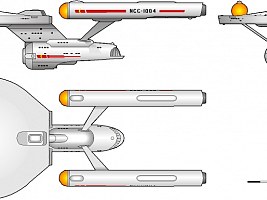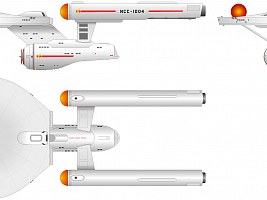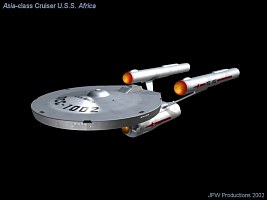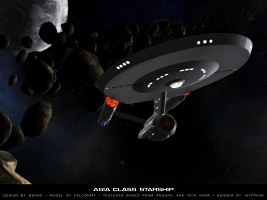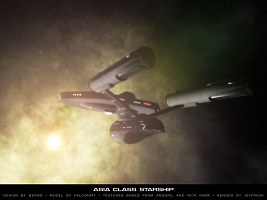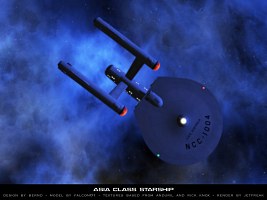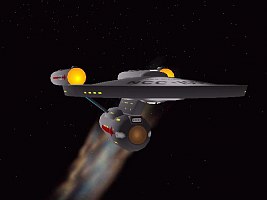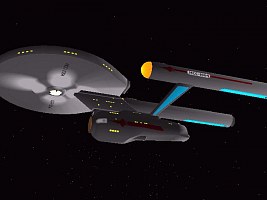Asia Class
At the end of the 22nd century, rapid progress in advanced propulsion, communications and weapon technologies would soon allow their introduction in production starships. However, Starfleet was still reluctant to allow these new starship technologies to be tested under actual operating conditions. Because of several disastrous experiences, Starfleet Command considered equipping front-line ships with experimental technology to be both risky and a waste of resources. Moreover, new technologies were often incompatible with a ship's existing systems, necessitating a costly and time-consuming systems overhaul to return everything to full operational status. Therefore, many developers of new technologies were forced to purchase or lease decommissioned ships as testbeds. The results gathered with these ships were valuable in that they could determine whether a single system performed properly within specified parameters, but they could not anticipate how the system would perform in a next-generation starship.
Starfleet's apparent lack of interest in emerging technologies also dissatisfied the Starfleet Corps of Engineering. In 2190, finally, the Corps of Engineering successfully submitted a proposal to Starfleet Command for the construction of a completely new prototype ship, highly modular and incorporating all the latest technologies in a single hull. The decision to commence development of the new class coincided with a request by the Federation Science Council for a larger, faster ship design for long-term exploration. The Science Council argued that because Federation territory had expanded so rapidly, many outposts and colonies in the outer territories had not been visited by science vessels since initial survey missions decades before. On the other hand, the Science Council was not willing to maintain a fleet of large armed vessels, which would naturally be under the control of Starfleet. In 2191 the Federation Council decided to provide the Science Council with part of the necessary funding but also chose to place science missions at or beyond Federation boundaries under the command of Starfleet. This decision was instrumental in the foundation of the modern Starfleet with both military and scientific roles.
70% of the development costs for the new Asia class were to be provided by Starfleet and 30% by the Science Council. Five ships, named for the five traditional continents on Earth, were to be completed by 2195, but construction of only the lead ship, USS Asia NCC-945, was initially approved. The reason for this limited approval was that the cost of the new ships was expected to be many times higher than that of normal cruisers owing to the use of experimental or custom-designed technology instead of standard components. The construction of additional ships was nearly cancelled; however, in 2197 construction of USS America NCC-991 and of the three remaining "continent" ships was approved. To complete the prototype ship, contracts were signed with an usually large number of constructors, many of which were actually consortia of companies, the most important being Yoyodyne for propulsion and power-generation systems. Final assembly of the ships was to take place at the San Francisco Fleet Yards.
USS Asia was launched from the San Francisco Fleet Yards on April 23, 2204, in a ceremony attended by many high-ranking members of the Federation Council. Shortly after the ceremony a severe maladjustment developed in the antimatter containment field of Yoyodyne's newly developed matter/antimatter reactor, which prevented the warp core from being safely activated for a full year. After the containment field was successfully readjusted, the new warp core performed extremely well. In fact, similar reactor designs with dedicated long channels for matter and antimatter are still omnipresent in the 24th century. The next ship, USS America, followed in 2206, and the three other "continental" ships were commissioned in the following year.
Although Asia-class ships carried the most advanced technology of their time, their offensive capabilities could be considered adequate at best. On either side of the saucer were two type-5 phaser arrays, which could be easily swapped out. Unlike other contemporary phaser prototypes, the type-5 phasers already employed surface facets for beam emission rather than rotating turrets. The absence of mechanical components was intended to increase targeting speed and durability, but performance was poorer than expected, and after two years the type-5 phasers were replaced with the standard phaser emitters. The missile launch bays were able to hold as many as four of the latest fusion-tipped missile types. Additionally, a newly developed matter/antimatter weapon, informally dubbed "Thor's Lightning", entered service on USS Asia in 2206 and on the four other ships in 2208. This self-propelled device was essentially a conventional missile, whose fusion warhead had been replaced with an arrangement of matter and antimatter pods. When this missile was first introduced the risk the that antimatter containment of a single pod would fail was still rather high, and the cumulative risk on a ship carrying up to 20 missiles, each with four independent pods, was considerable. However, subsequent advances in antimatter containment essentially eliminated the risk of failure, and with the introduction of new acceleration tubes the weapon became the familiar photon torpedo.
The Asia class was the first to be fully equipped with subspace radio and celerotronic computer technology that would become standard for the next 50 years. In addition, the Asia class introduced significant advances in computer, life support, and power systems. Despite these innovations, a small group of military strategists still regarded these systems as being less important than weapons performance and speed as long as they performed just fine. However, the clearly improved systems of the Asia class were quickly adopted for military ships as well. Only one ship of the Asia class, USS America, ever suffered heavy battle damage. In 2219, she was ambushed by two Klingon D3 cruisers and subsequently retired from service. Four starships of the Asia class were nearly completely reconstructed from 2262 to 2265.
Gallery
Datasheet
| Class specifications Ship type: Light cruiser Length: 225m Width: 99m Height: 55m Crew complement: 280 Max. speed: Warp 5.1 First commissioned in 2204 |
Commissioned ships USS Asia NCC-945 USS America NCC-991 USS Africa NCC-1002 USS Europe NCC-1003 USS Australia NCC-1004 USS Jefferson NCC-1073 USS Manhattan NCC-1074 USS Yukon NCC-1105 USS Thule NCC-1106 |
Credits
Thanks to Jan Seebald, Jetfreak, Conner Bentley and Jay Hagen for their 3D models.






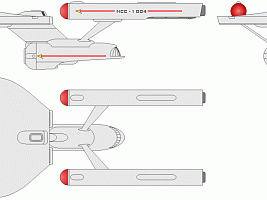
 Preliminary three-view schematics
Preliminary three-view schematics